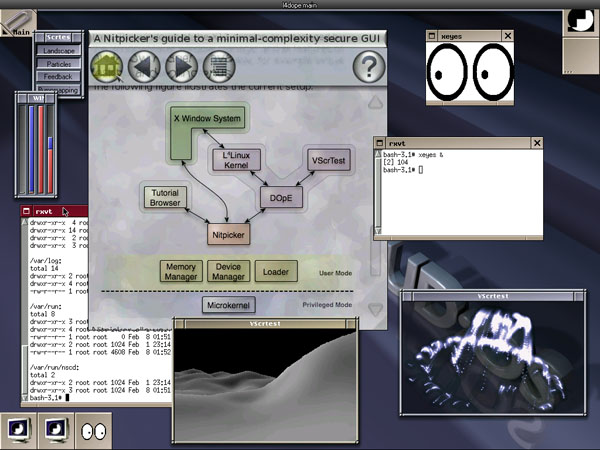
 |
| Home • Reviews • Forums • News 2015 • 2013 • 2012 • 2009 • 2008 • 2007 • 2006 • 2005 • 2004 RSS Feeds • FOV Factor Table • Sensor Sizes | Definitions: A-D • E-H • I-L • M-P • Q-U • V-Z | Sitemap Articles • Archived Websites (Pre-DigitalDingus): D100 Lounge • E-10 Club | Contact |
Technical University of Dresden presents demo OS with multiple Linux kernels |
| March 16, 2006 |
The developers of the TUD:OS operating system have created a Live CD that can be downloaded. The system is based on the Fiasco Microkernel. It has less than 20,000 lines of source text (compared to more than one million lines in a current Linux kernel) and, unlike a monolithic kernel, only contains process management functions and basic functions for synchronization in communication. All other system components, such as memory management, program loading, device management, and applications, do not run as privileged kernel modules, but rather in protected user-level areas of memory. Thanks to efficient task and context switches, modern microkernels are generally also useful in real-time applications, unlike first-generation microkernels such as the Mach kernel in Mac OS X. TUD:OS is operated via the Nitpicker minimal user interface. It does not matter that much that there is practically no software for it because the Fiasco microkernel can launch other operating system kernels as though they were normal application programs, such as a slightly modified Linux version called L4Linux. Within these Linux systems, users can run X-Window programs as usual. Current Linux programs are binary-compatible. As running systems are hermetically sealed, the Technical University of Dresden believes there is no danger of the system used to surf becoming infected and passing on the virus to another system. Drivers also run as user processes, for instance from other Linux distributions. The "Device Driver Environment" (DDE) provides the functionality of the original system. The L4 Virtual File System Layer (L4VFS) provides a POSIX-compatible file system. Furthermore, the programmers at the Technical University of Dresden also ported the C++-Framework Qt in version 3.3 so that Qt programs can also be used in Nitpicker. They merely have to be retranslated. TUD:OS requires at least a Pentium 3 CPU with a clock frequency of 1 GHz, 256 MB of RAM, and a VESA 2.0- compatible graphics card. The system supports PS/2 and USB keyboards and mice. The download area also offers configuration files for the VMware PC emulator. (Craig Morris) DigitalDingus Note The downloadable TUD:OS ISO file is 118MB and the TUD:OS GZ file is 74MB. |
| Home • Reviews • Forums • News 2015 • 2013 • 2012 • 2009 • 2008 • 2007 • 2006 • 2005 • 2004 RSS Feeds • FOV Factor Table • Sensor Sizes | Definitions: A-D • E-H • I-L • M-P • Q-U • V-Z | Sitemap Articles • Archived Websites (Pre-DigitalDingus): D100 Lounge • E-10 Club | Contact |